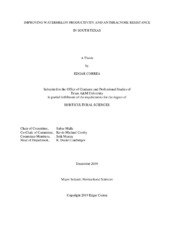| dc.description.abstract | In 2018, the production value of watermelon in the United States was $657 million out of 2.0 Mt harvested. That same year, Texas was second largest watermelon producing states with 0.40 Mt harvested. The first objective of this study was to evaluate the yield potential of genotypes in south Texas, while the second objective was to improve our understanding of how anthracnose race 2 affects watermelon. In 2018, there were 34 genotypes tested at three locations (College Station, Uvalde, and Weslaco, TX). In 2019, 20 of the previous 34 genotypes were evaluated. The germplasm was evaluated for total yield, soluble solid, rind thickness, fruit length, circumference and weight. In the first year, TAM 2, ‘Sunshade’, ‘Chubby Gray’, and ‘Big Crimson’, had high total yield, 31 to 29 Mg ha-1.
During the second year, ‘Sunshade’ showed high total yield, 36 Mg ha-1, once again. Path analysis indicated that fruit weight and total fruit could indirectly select for total yield, with direct effects of 0.93 and 0.92, respectively. Correlation to total yield showed fruit weight (r2 = 0.48) to have a higher correlation than fruit number (r2 = 0.17). Study allowed us to gain a better understanding of watermelon, identify potential parents for population development, and to further the watermelon breeding program. The second objective was to improve the understanding of anthracnose, couple of studies were conducted; inoculation procedure optimization, germplasm screening, and population genetic study. The procedure optimization looked at different anthracnose race 2 inoculum concentrations and potential DAI to rate seedlings for disease severity. The results indicated that 100,000 spore mL-1 was an adequate inoculum concentration to screen watermelon seedlings and 8 DAI was an optimal day to rate seedlings. The germplasm screening evaluated previously screened genotypes for anthracnose race 2 resistance. The AU-series developed in Alabama showed resistance, as did PI 189225 and 271778. In the population genetic study, four different F2 populations were evaluated for anthracnose race 2 resistance, with the goal of looking at the mode of inheritance. | en |


